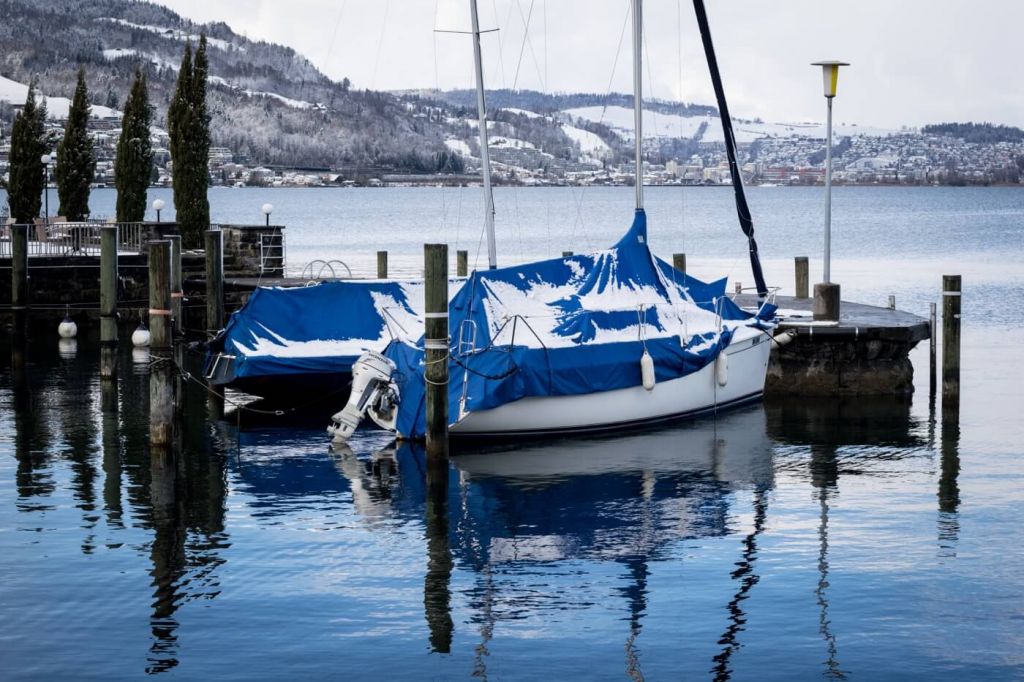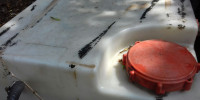9 Tips for Winterizing a Boat that Stays in the Water
Storing your boat for the winter in the water has advantages and is an appealing option since it can be cheaper and sometimes better for the boat. In a temperate climate you have to deal with winterizing and storing your boat, but what are the different needs if you wet store? What are the extra risks?
What do you need to do to best protect your boat?
Most of your winterizing tasks are the same, but there are a few ways to make your in-water storage safer for your boat.

Here are 9 Tips for Winterizing a Boat that Stays in the Water:
Get a Good Cover and Maintain It
Covering a boat can be a substantial expense, whether you use a permanent canvas cover which is custom made for your boat or you shrink wrap it every season. The budget option of building your own framing and using inexpensive tarps is tempting when you figure the per foot costs of shrink wrap, but you be very careful doing this.
Shrink wrap or a properly installed canvas cover will give you the least troubles over the winter whether your boat is on the hard or in the water. Improvised coverings from off-the-shelf materials are more likely to fit poorly, work loose, leak, flap in the wind, or in some other way become compromised and require fixing.
Any problems you have with your cover will be magnified if your boat is in the water for the winter. The initial installation of a cover is more challenging as you need to run lines under the boat in the water to secure the cover. If the cover comes loose and drops in the water, recovery and replacement is more difficult. Especially if the cover or its lines get frozen in place in a deep cold.
When you visit your boat over the winter, inspect the cover for tears, stretching and wear and address any problems you find immediately. After major snow, ice, wind or rain event is a good time to check your cover.
Shore Power and Battery Care
With the boat in the water, you will need battery power for a bilge pump. In most in-water storage locations, shore power is available so you can keep a charger on the batteries. If it's not available, you will need to give some thought to how you will make sure your bilge pumps will work all winter.
Shore power connected to a boat for a long period is not without risks. Inspect all connections and make sure there is no risk of water intrusion and freezing or shorting at the connections on the boat and on the dock.
With shore power available there is a temptation to "leave things on" and maybe not winterize them. Hot water won't freeze, right? Do not do this. Your marina is not immune to power failure, and the whole boat will still get cold even if a few systems are left hot.
Consider a Heater
The good news is that the water your boat is sitting on is a giant heat sink and buffers the effects of cold air on your boat. Boats on the hard chill faster and are more subject to rapid freezing than boats in the water. That doesn't mean you are free from risk, it just means the chances are better that a short freeze won't hurt your boat.
But your boat is in the water all winter. You will have more moisture, dampness, and humidity than a boat on the hard so you may be more prone to mold and mildew. If you've got shore power, think about a small low-wattage cabin heater in the cabin or the engine room to keep the inside above freezing and dry out the air.
You still must winterize systems in case the power fails or a deep cold overwhelms the heater, but it will cut your risks for damage and mold.
Think before using a dehumidifier. Those will need to be emptied before they freeze, or set to drain overboard, which is a challenge when all your thru-hulls are closed.
Ice Eaters Are Your Friend
Though salt water freezes at a lower temperature than fresh water (on average 28.4°F or -2°C for ocean water) it can still freeze in a long cold spell. A thin film of ice that doesn't persist won't hurt your boat, but if it gets thick, your boat can suffer from crushing effects from the ice and damage from encasing ice as the tides change.
Most marinas that wet store boats have "ice eaters" (electric propellers in the water) or a bubbling system to prevent thick ice from forming around your hull. Make sure this is the case, and if it isn't, make sure there's power to the dock and you know how to install your own properly and safely.
It is unnecessary to have ice prevention in place and turned on all winter, and most marinas will not leave systems in the water if freezing is not a risk. Equipment left in the water is always at hazard, so there are legitimate reasons to only install ice eaters when the weather predictions show extreme cold and remove them in warmer weather.
So watch the weather and make sure your marina is on top of it. Ice eaters are not a guarantee to stop all ice, but they will help ensure that any ice that forms will be thinner around the boat, reducing the risk of damage.
The Bilge and its Pumps
A functional bilge pump is an absolute necessity when wet storing your boat. If you can not keep your batteries charged to support a bilge pump, reconsider wet storage. If no shore power is available and you covered your boat, you may have difficulty keeping batteries topped up if anything is left turned on.
Wiring your bilge pump directly to the batteries and bypassing the boat's main power systems is a good option if you can't stay plugged in all the time (and even if you can). This allows you to turn off the main power switches and disconnect the batteries from the boat to eliminate parasitic drains, while keeping your batteries better topped up and used only by the pumps in an emergency.
If you bypass the electrical panel, include an appropriate fuse or breaker in your bypass wiring. A fire is even worse than sinking in the slip.
Take extra care to drain your bilge and clean it so there is nothing to block intakes on the pump. Add extra strength non-toxic antifreeze to insure pumps are not damaged and things do not freeze or turn to slush. A frozen bilge pump can get damaged if it's activated by a float switch.
Dock Lines, Chafe Guards and Fender Care
Setting your boat in the slip carefully will help prevent damage and wear. If possible, secure your boat so it is in the middle of the slip and not touching anything instead of tight against the dock. While suspending your boat off the dock makes getting on board more difficult, unless you are planning a major project over the winter the benefits are much more than the hassle.
All dock lines should have chafe protection everywhere they contact the boat or the docks. Lines that chafe through are a top reason for boat damage in the winter. Several commercial chafe protection products will work, or you can wrap all the contact points with a rugged tape such as Gorilla Tape, though it will be tough to remove in the spring. Keep some on hand to make spot repairs if you see chafe during the winter.
Your fenders need to be adjusted so they are out of the water, as should all fender covers and trailing lines. It's not just the things that will grow on them, if there is a freeze and they get caught in the ice you could lose the fender or put unwanted strain on the fitting it is tied to.
Check Under the Boat
Before you leave your boat for the winter, check under the water make sure you aren't setting yourself up for trouble. In particular, ensure that all your sacrificial zincs are in shape to make it through the winter. Replace them if you have any doubt.
This is critical, as stray currents that cause galvanic corrosion are often found near docks with shore power. It's possible you may be in a different slip than usual for the winter and the currents may be stronger than you know. Even if you have a galvanic isolator on the boat, new zincs will help protect you.
If your bottom paint is due for refreshing, consider the wisdom of wet storage. Marine growth will slow over the winter, but it will not stop. At the end of fall and the start of spring it will speed up again, and if you enter the spring with little effective antifouling, you may get caught in the spring hatches of marine pests when the worst settling of barnacles and other hard growth happens.
At a minimum, plan for and expect a good bottom cleaning in the spring, whether it's in-water with a diver or with a short haul and pressure washing. And have a spare set of zincs.
Close Your Thru-hulls and Plug Exhaust Ports
Except for your bilge-pump outflow, all thru-hulls at or below the waterline should be closed and winterized. When they are closed, disconnect all hoses and drain them, and use a cloth or suction device to get any water left in the seacock out before reconnecting the hoses.
It cannot be emphasized enough that unneeded thru-hulls are left open. Thru-hull and hose failure, especially from freezing, is the number one risk to your boat when it's stored in the water for the winter.
Even above the waterline, thru-hulls and engine exhaust outlets close to the water should be closed or covered. If there is an accumulation of snow and ice on your boat over the winter your boat will be pushed lower in the water and these may get submerged, and you may never know it. Even if it doesn't sink your boat, water which floods the exhaust system can cause significant damage.
Remove transducers from their fittings and insert blank plugs if you have them. This will save wear and prevent growth on the sensors.
Plugging external ports will also keep out any small pests which may take up residence. Just don't forget the plugs in the spring.
Visit Your Boat
This tip is last, because if you remember nothing else remember that the best way to prevent problems when your boat is in the water is by visiting it. Most damage in the off season doesn't happen from sudden and catastrophic events, rather it's the cumulative effect of small problems which develop unnoticed into larger ones.
Make time to check on your boat every couple of weeks. Things to look at include:
- Battery charge states; make sure they are topped up and full. Charge them if they are not. If they are discharged, figure out why. Perhaps your bilge pump has been running.
- Water in the bilge. No amount water coming in over the winter is acceptable. Don't forget that water can come into the bilge from outside leaks, or even accumulate from condensation. But any accumulation of water indicates a problem that merits further investigation.
- Shore power connections. Check for shorting, warmth, water ingress and that breakers have not tripped.
- Leaks, holes, or loose spots in your covering. Look for damp spots on the deck, wear spots, loose tape on shrink wrap, chafing in lines and tie downs.
- Chafing on lines where they contact the boat or dock.
- Fenders and lines that may have slipped or loosened and be in the water.
- Inspect and test that your bilge pump still works. Just a quick test of the float switch, you don't want to pump that antifreeze out!
Did you find the answer to your specific question?
👍 4 👎 1


Comments
David Lechner
In the article - you say “Except for your bilge-pump outflow, all thru-hulls at or below the waterline should be closed and winterized. When they are closed, disconnect all hoses and drain them, and use a cloth or suction device to get any water left in the seacock out before reconnecting the hoses.”
Then….
“It cannot be emphasized enough that unneeded thru-hulls are left open.”
So - why would we leave the unneeded holes open? Do you mean “are closed” ?
Or do we need the sea water to be circulating into these openings?
(and - do you have an article on winterizing the hoses and systems?)
Thanks!
Felix Meyer
Great!!! Thank you for sharing this details. If you need some information about SEO than have a look here <a href=”http://2cool2.be/url?q=http://webemail24.com/increase-your-online-income-through-email-marketing">Webemail24</a>
Seoranko
Nice post! You have written useful and practical information. Take a look at my web blog <a href=”http://nash-suvorov.ru/go/url=http://seoranko.de/wie-man-online-werbung-effektiv-gestaltet">Seoranko</a> I’m sure you’ll find supplementry information about Apartments you can gain new insights from.
Leave a comment